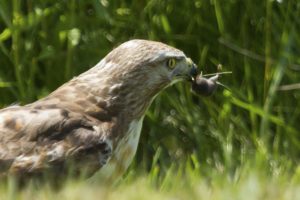This article was written by Jessica Johnsrud, education coordinator. Photo (Red-tailed Hawk eating a mouse) taken by Nancy Nabak, communications coordinator.
Mice are the most abundant mammals in Wisconsin, so it’s no surprise many of us find evidence of their invasion in our homes. As the days get shorter and the weather turns colder, one may find mouse droppings or even hear the pitter-patter of scurrying feet in the walls or above the ceiling.

Red-tailed hawk eating mouse
There are several kinds of mice in Wisconsin, but the species most likely to hole up (literally) in our houses for winter are the White-footed Mouse, Deer Mouse and House Mouse. All three species are common in the area and look very similar. They have large, naked ears that give them a keen sense of hearing. They also have bulging eyes and long whiskers that help them navigate at night, when they are most active. There is quite a variation in color from gray to light brown to reddish brown. Mice are small rodents, but the House Mouse is noticeably smaller at just 2.5-4 inches in length.
Interestingly, not all mice are native to Wisconsin. The House Mouse was not known in the United States until around the time of the American Revolution when it’s believed to have arrived as a stowaway on transatlantic ships from Asia. The species is now found throughout the entire continent, but cannot tolerate winter. In regions with cold temperatures such as the Midwest, the House Mouse will seek refuge in houses, heated barns and other buildings.
Mice are active year-round, even in the winter. They stay in their nest during the coldest winter days or during periods of heavy rain. Their nests are loosely constructed using dried grasses, mosses and other plant materials and have a hollow center. The center is made to be cozy for the mouse and is lined with soft items such milkweed seeds or animal hair. Outdoor nests can be found under or inside logs, inside standing dead trees or in small depressions in the ground. Once mice enter houses and buildings, they use insulation, paper and other human materials to make a nest in the walls or just about any nook or cranny.
Many people are surprised to learn that mice are omnivorous and eat both plants and animals. They dine on seeds, fruits, nuts, insects, worms and even carrion (dead animals). In the fall, they cache away food until it is needed during the colder days of winter or when food is scarce.
For most people, mice are unwelcome visitors inside our dwellings. However, they do serve an important role in the natural world. Mice are a very important food source for many animals including mink, weasels, owls, hawks, fox, coyote and some species of snakes.
